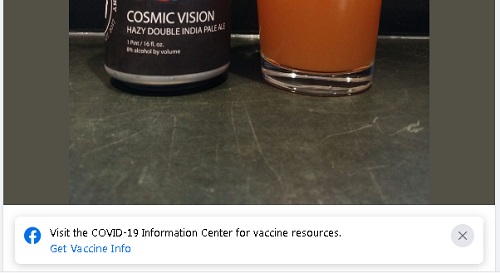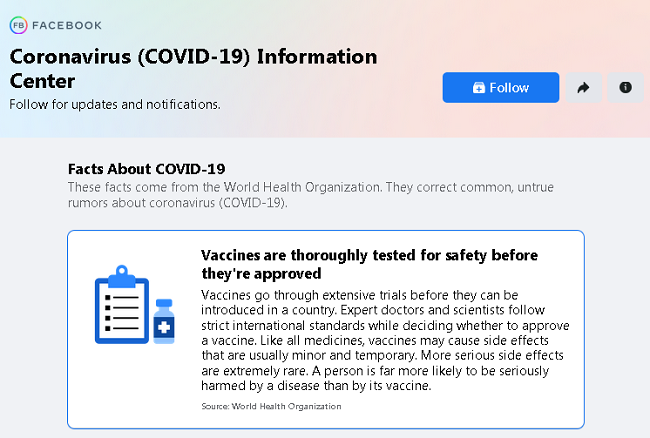COVID Beer?
If you’ve been on Facebook lately you’ve likely seen their additional info bars for various topics including COVID information. Here’s one such example of a friend highlighting a favorite beer choice to enjoy after his second COVID vaccine shot.

Mention the word “COVID” and you might get the badge of honor from Facebook’s “fact checkers.”
Facebook’s take
Clicking on the link takes one to Facebook’s info page on various matters relating to the SARS-CoV 2 situation.

The top-shelf “rumor” deals with how vaccines are approved for use in the populace. Clicking on the World Health Organization (archive) link brings us to these important statements.
Reviewed and current on 19 February 2021. Vaccination is one of the best ways to prevent diseases. In total, vaccines are estimated to save between 2 and 3 million lives every year. Together with governments, vaccine manufacturers, scientists and medical experts, WHO’s vaccine safety programme is constantly helping monitor the safety of vaccines. This helps ensure that vaccines are safe for you and your family.[1]
That’s very encouraging news. Here’s a bit more with some emphasis on COVID-19…
The most commonly used vaccines we have today have been in use for decades, with millions of people receiving them safely every year.
In addition, there are several new vaccines under development. If approved, these will help prevent more life-threatening diseases – such as COVID-19, Zika or Nipah viruses – or improve the effectiveness of existing vaccines.
As with all medicines, every vaccine needs to go through extensive and rigorous testing before it can be introduced in a country. Once they are in use, they must be continuously monitored to make sure they are safe for the people who receive them.[1]
Emphasis added with the implication the COVID-19 vaccines, as of the date of this article, are not yet approved.
Reading on…
In countries where vaccines are manufactured, national or regional regulators oversee a vaccine’s development. This includes approving clinical trials, evaluating their results, and taking decisions on licensing. In deciding, regulators must refer to very strict international standards on acceptable ethical clinical practice.
Once a vaccine has been developed, national regulators decide whether to introduce a vaccine in their countries. WHO provides information to support this process, through comprehensive evaluation of the available evidence, and its regularly updated position papers on vaccines.[1]
Emphasis added to segue to the US and its regulatory body… the FDA. Here is a link to the current list of “approved” vaccines for the US…
FDA: Vaccines Licensed for Use in the United States [2]
As of April 12, 2021 (archived), none of the three available vaccines “authorized for emergency use” have the minimal requirements to qualify being on the “approved” list and likely won’t for a couple years. The FDA makes quite clear the distinction between “approved” and “authorized for emergency use.”
FDA: Emergency Use Authorization [3]
(Archived)
Their video highlights the difference and the reasoning [4]…
Folks getting the COVID vaccine should understand they are part of the experiment during the emergency use authorization (EUA). Some do. Some clearly do not.
Peer pressure no substitute for logic
WHO and the FDA are clear on the difference between approved and authorized for emergency use monikers on medicines and vaccines. That this nuance is lost for a large number of people reveals the how well misinformation makes its way to the populace. The twisting of words generates peer pressure not based on the scientific and legal realities. Our young adults appear to bear the brunt of this marketing. The Virginia Mercury reports the following…
COVID-19 cases are growing among younger Virginians… [5]
The overall number of cases in Virginia has really decreased,” said Deputy State Epidemiologist Caroline Holsinger. “But what we are seeing is that the percentage of cases among 0 to 19 year-olds has increased.
Hard numbers to make sense of this statement are missing from this article. Being a larger percentage of a smaller number requires calculation to verify, but the article offers no such help.
In Virginia, approximately 30 percent of infections from the B.1.1.7 variant are found in patients under the age of 20, Holsinger said. There’s still no definitive evidence that it or other recently discovered strains are more likely to infect children and data also suggests that available vaccines are still highly protective against them. But B.1.1.7, especially, is both more infectious and can potentially cause more severe illness — even among younger patients.
“We can’t necessarily look at our data in Virginia and draw any absolute conclusions,” she said. But recent hospital numbers are also causing some concern. According to Holsinger, the majority of hospitalizations nationwide are occurring among 18 through 49 year-olds and 50 through 64-year-olds.
With a year of data in the books, we know a whole lot more now than we ever have. Later in the article…
On a more systemic level, the worry is that older children and young adults are drivers of transmission. Epidemiologically, they’re more mobile and more likely to participate in risky behavior, Avula said — part of why the state has been focused on vaccinating college students before they break for summer vacation (those plans may be pushed back after a significant decline in next week’s shipments of Johnson & Johnson vaccine).
I have direct evidence one Virginia college is making it all, but mandatory to receive the Pfizer vaccine. They mention the VA Department of Health will contact each student to schedule their injection during a two day window. The wording leaves little room for objections and prays on the naivety of our young adults who can make legally binding decisions leveraging the least experience. The peer pressure is strong in our government facilitated by their non-government enforcers.
Vaccines still make the most sense for older
The article continues…
And while it’s still uncertain whether variants can (or will) worsen symptoms among children and young adults, there’s ample evidence that the risk of severe infection increases with age. With roughly 80 percent of Virginians still not fully vaccinated, the big worry is that continued spread will lead to a new surge of hospitalizations.
Vaccinating those most at risk, the old, the sick, the fat, etc. with the limited vaccine supply makes the most sense IMO.
That social media machines are pumping the effort to coerce the young to get vaccinated… just because… should trigger chin pulling concerned looks from everyone. Facebook’s choice of wording fits right in.
Conclusion
Facebook’s assertion “Vaccines are thoroughly tested for safety before they’re approved” while technically accurate, suggests to the casual reader the available COVID-19 vaccines have met the standard for approval. As of April 12, 2021, this is not the case in the US.
References
- https://www.who.int/news-room/q-a-detail/vaccines-and-immunization-vaccine-safety
- https://www.fda.gov/vaccines-blood-biologics/vaccines/vaccines-licensed-use-united-states
- https://www.fda.gov/emergency-preparedness-and-response/mcm-legal-regulatory-and-policy-framework/emergency-use-authorization
- https://www.youtube.com/watch?v=iGkwaESsGBQ
- https://www.virginiamercury.com/2021/04/12/covid-19-cases-are-growing-among-younger-virginians-worrying-state-health-officials/

You must be logged in to leave a reply.